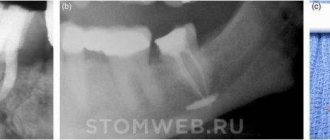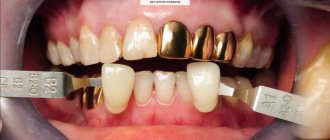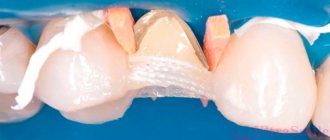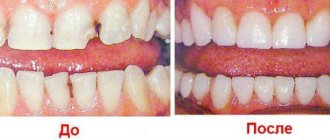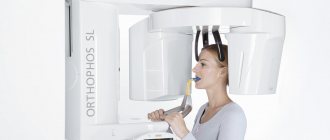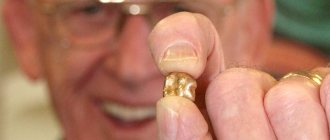Common materials used to make veneers include photopolymer composites, porcelain, and zirconia. One of the most popular compositions is dental ceramics, used both in the creation of solid cast products and in the lining of metal frames. Ceramic veneers installed on the front teeth guarantee the restoration and preservation of smile aesthetics for a long time.
Dental ceramics are used to make feldspar veneers - a category of materials that combines various compositions based on quartz and feldspar. The main difference from porcelain used to create household products is the absence of kaolin, due to its vulnerability to coloring elements. The structure of the composition, as a rule, is a mixture of microcline and albite (feldspar) and quartz, in a ratio of 65/25%, as well as additional elements that ensure the strength of the finished microprostheses. Feldspathic ceramic veneers belong to the most affordable category in terms of cost, but their characteristics in most respects are not inferior to alternative models.
Indications
Ceramics are used to make aesthetic dentures with or without a metal frame. With its help you can make:
- thin veneers less than 0.6 mm thick and regular veneers (only made of glass ceramics);
- occlusal veneers;
- inlays and crowns;
- endocrowns;
- root posts (made of oxide ceramics);
- stump pin inlays (with a pin made of oxide ceramics);
- bridges supported on inlays (with a frame made of oxide ceramics);
- three-unit bridge-like dentures, as well as long-length bridges;
- dental implants (made of oxide ceramics);
- abutments;
- artificial teeth of removable dentures (made of glass ceramics);
- gingival part of conditionally removable and fixed dentures (glass ceramics).
Classification by purpose
Dental ceramics are used for various purposes. Depending on this, it is divided into frame, monolithic and facing. Frame – used for the manufacture of crowns and bridges. Facing – metal (cermet) or ceramic (metal-free ceramics) frames are veneered. Monolithic – designed for making complete dentures.
The requirements for these varieties are different. The framework ceramics must be very durable, the veneering metal-free ceramic crown must have good aesthetic characteristics and reliable adhesion. Monolithic ceramics are generally the strongest of all, so require less invasive preparation and provide longer prosthetic life. Only lithium oxide and disilicate glass ceramics are suitable for its manufacture, while aluminum oxide requires additional lining due to its high abrasiveness.
Contraindications to the use of ceramics
- Low-strength ceramics cannot be used under increased occlusal loads, including in patients with bruxism.
- It is prohibited to manufacture ceramic dental bridges if their bending strength is less than 350 MPa.
- Lithium disilicate ceramics are not suitable for the manufacture of bridges longer than three units.
- The material is also not used for deep subgingival preparations if adhesive fixation is required.
- It is contraindicated if the preparation depth is insufficient.
- It is not used if there is a need for subsequent non-destructive removal of the structure, with the exception of screw ones.
Classification of ceramics by level of transparency
The level of transparency of dental ceramics is indicated in Latin letters:
- HT (High Translucency) – high transparency;
- LT (Low Translucency) – low transparency;
- MO (Medium Opacity) – medium opacity;
- HO (High Opacity) – high opacity.
These four levels are typical only for glass ceramics. Oxide ceramics only meet the HO level. Zirconium oxide belongs to the MO level and does not correspond to the specified HT. The higher level of transparency of zirconium oxide is explained by a decrease in the porosity of the material. Less porous - scatters light less, acquires transparency and higher strength.
The choice of ceramics with a particular transparency depends on the type of denture and the color of the supporting tooth. Highly transparent ceramics are suitable for partial restorations and are not suitable for crowns due to the prospect of translucency of the dark oral cavity. Monolithic dentures are recommended to be made from HT and LT ceramics. To completely or partially cover the shade of the prepared tooth, HO and MO are used.
Advantages and disadvantages of ceramics in dentistry
Ceramics make it possible to produce dentures that are almost impossible to distinguish from real teeth. In this indicator, it outperforms amalgams and metal alloys, unlike which it also has low thermal conductivity. It can be used to make dentures for vital teeth. Such designs do not have the disadvantages of metal dentures, however, prices for metal-free crowns are always higher. In addition, ceramics are more fragile than metal, and therefore require careful handling during preparation and do not tolerate sharp transitions.
Composite materials are in no way inferior to ceramics, but they have an undeniable advantage. It is more durable and has increased biocompatibility, since it does not contain organic components. Ceramic materials have record color and wear resistance, as well as bending strength, but they are more fragile than composites. Therefore, some authors recommend choosing composite materials for implant-supported prostheses.
Among the obvious disadvantages of ceramics is low repairability, especially in the oral cavity.
The evolution of prosthetics. Triumph of ceramics. Part two
Daria Bendarskaya journalist Dental Magazine
The idea of using porcelain in the manufacture of dentures later received active development, not only in the Old World, but also in the New World: there are no geographical boundaries for ingenious solutions.
Personal motivation as the engine of progress
In Europe, Pierre Fauchard's main followers in working with porcelain were his two compatriots - the pharmacist Alexi Duchateau and the dentist-surgeon Nicolas Dubois de Cheman.
Duchateau himself wore dentures made of ivory and learned from his own experience that it was impractical, unhygienic and unaesthetic: the porous bone absorbed saliva and the remains of liquid food, acquired a dirty color over time and caused a strong bad breath. So the pharmacist was looking for a replacement denture and, after a series of experiments, with the help of specialists from a porcelain factory in Saint-Germain, he made his first porcelain denture.
As for Dubois de Cheman, he managed to solve the problem of porcelain shrinkage during firing. In 1789, he received a patent in England for porcelain teeth, the material for which was supplied to him by the English company Wedgewood. The dentures were made by sintering feldspar, silica and kaolin. True, at first the dentist himself called his products not porcelain, but mineral. The fact is that porcelain was treated as a very fragile material, and such a reputation for porcelain would only harm Dubois de Cheman in popularizing his invention. For comparison, if in 1797 3 thousand sets of complete removable dentures were sold, then by 1804 - already 12 thousand.
Portrait of Dubois de Chemans. Source: wikimedia.org
Complete removable dentures made of gold and porcelain. Source: flintsauctions.com
At the beginning of the 19th century, dentist Giuseppe Fonzi developed a technology for making porcelain dentures with metal pins. This technology was a breakthrough in prosthetics. The design made it possible to make complete removable dentures for the upper and lower jaws. Each porcelain tooth, which was secured in a gold prosthesis using a platinum pin, had its own independent “suspension.” The pins themselves enabled the dentist to fine-tune the dentures individually for each client. And, importantly, the palette of shades of porcelain teeth made it possible to choose the most suitable option so that the prosthesis looked completely natural. By the way, Giuseppe Fonzi, during his cruise through Europe in 1824-1825, designed and installed prosthetics for Alexander I. They were incredibly expensive for the Tsar’s treasury. And the autocrat became the first Russian emperor to acquire dentures.
At the end of the 19th century, among private practitioners abroad and in Russia, the practice of cutting out deposits from porcelain pieces and cementing them into previously prepared carious cavities was popular. In the 1870s, the above-mentioned dentist Land developed a special mass for inlays, but its disadvantage was that it had a high melting point and exhibited significant shrinkage during firing. A few years later, in Germany, in Dresden, Porcelain Enamel was created, which was used for a long time all over the world.
On the other side of the ocean
The mid to late 19th century was a period in the history of dentistry when experiments with ceramics progressed with varying degrees of success. New inventions were required for this direction to receive further active development. Dentists tried to combine the best qualities of two materials - ceramics and metal, to find the optimal technology and solve the problem associated with the strength and aesthetics of ceramic dentures on a metal frame.
Prosthetics was actively developing not only in Europe, but also in the USA. Industrial production of artificial porcelain teeth in the country began in 1825. In 1884, dentist Broke developed a porcelain bridge design in which a platinum-iridium alloy was covered with a ceramic shell. Although the technology itself was not widely used due to the fact that prosthetics were quite difficult to manufacture and were not durable, this technology was used in Russia until the beginning of the 20th century.
In 1885, a method for custom-making a pin artificial tooth was patented, in which a porcelain veneer was sintered directly onto a platinum post. The prerequisite for the manufacture of a porcelain shoulder crown, called the "jacket crown" or "jacket crown", was the use of platinum foil by dentist Land when modeling ceramic crowns in 1887. Later, he also described a method for making porcelain crowns using foil directly using a kiln. With some modifications, this technology is still used today. Land had many opponents who believed that such a fragile material as ceramics could not be used to create artificial teeth. But his students proved the promise of the innovative methodology.
By the end of the 19th century, two main directions for the use of ceramics in prosthetics had been identified: cladding of metal frames (metal-ceramics) and metal-free ceramic structures.
Mold for making dentures. France, early 20th century. Source: medicalantiques.jalbum.net
Ideas and technologies
In Europe, jacket crowns have become widespread since the 1920s, using gold as a frame material. In the 1920s and 1930s, new ceramic dental masses of American, English and German production appeared, as well as new kilns, supplemented with silit heating elements. In 1925, dentist Albert Le Gros described the main stages of using ceramics in prosthetics.
In 1937, on the basis of the Leningrad Porcelain Factory. M.V. Lomonosov opened a factory of teeth made of porcelain and dental cements. Artificial teeth were produced in 18 different shapes and 9 colors. In 1947, the Leningrad Union Plant of Dental Materials was founded. At the end of the 1950s, the first Soviet porcelain mass FIL-1 was created with a melting and firing temperature of about 900 degrees. This temperature made it possible to use gold foil for firing. The industrial production of artificial teeth from ceramics in the country was in full swing: equipment was modernized, technology was improved, and production volumes grew. At the same time, the industry for the production of artificial teeth from plastic developed.
At the end of the 1940s, significant progress was made in improving the technology for making artificial teeth from ceramics. In the 1960s, research and experimentation began on creating ceramic compounds for single crowns; The technology for working with ceramics was significantly improved; they began to fire it in a vacuum. A technology for strengthening ceramics using aluminum oxide has also been proposed. During these same years, a patent was received in the United States for a gold-based alloy with a low melting point for the manufacture of a metal frame for porcelain crowns and bridges.
Thus, the second half of the 20th century became the era of metal-ceramics in prosthetics.
Students, future dentists, at work in the prosthetics laboratory. University of Otago. New Zealand. 1949 Photo source: Elaine Donaldson
Porcelain teeth. Circa 1925.
Aluminum mannequin for prosthetics. 1930s Photo source: atlasobscura.com
Was, is and will be
Despite the widespread use of metal-ceramic structures and acrylic, the idea of using metal-free ceramic structures has not lost its relevance for dentists. Since the 1980s, ceramics have been used to make veneers, inlays/onlays, crowns and bridges for the anterior teeth. In the 1990s, newer and more precise technologies were developed to create ceramic masses and luting cements. The fact that gold and metal structures began to lose their aesthetic appeal also played a role in the popularization of ceramic dentures: today patients want their dentures to be not only reliable, but also to look like real ones. Thanks to new materials and techniques, modern all-ceramic prostheses meet these requirements. But work to improve ceramics continues: the goal is to reduce the hardness of the material in the surface layer and its abrasive effect on natural teeth.
So ceramics remains one of the most popular materials in dentistry. Statistics confirm this: the need for ceramic prostheses increases every 4 years by approximately 50%.
Moving on to the first part...
Features of the technology.
The manufacturing technology of products comes down to four main operations: FORMING, DRYING, DECORATING, FIRMING.
MOLDING. Products are obtained from masses by plastic molding, slip casting, and pressing. The first option includes modeling, stuffing, rolling on machines with a template, and stretching on a potter's wheel. If the mass is well suited for a particular molding method, it is usually called: “pottery clay”, “clay for modeling”, “fireclay for stuffing”. However, almost any mass can be molded in any way if the molder has sufficient experience. Many masses can be adjusted in composition. For example, to improve plasticity, you can add 3-10% lump clay, to reduce deformation and improve drying properties - fireclay chips.
DRYING. Responsible operation. The main requirement for drying is uniformity. Those. All areas of the product should dry at the same speed. If necessary, quick-drying thin edges should be isolated from air flows (cover with rags, polyethylene). The faster the drying, the less shrinkage. The thicker the walls of the product, the longer they will dry: if 1 cm dries in 2 days, then 2 cm dries in 4 days, and 3 cm dries in 9 days. Large, heavy items need to be dried on dryers.
DECORATION. Ceramic paints, glazes, etc. are applied to the dry (or scrap) product. decorating materials. See relevant sections.
BURNING. The raw product is fired 5-20 hours in advance, usually 8-12 hours before the maximum temperature. It is important that the start of firing is slow enough to avoid the product exploding from the released water vapor. A good start is up to 200 degrees in 2-3 hours. Next, the usual heating rate is 1-3 degrees per minute to the final temperature.
E-max crowns: price 2022
How much does a ceramic crown cost per tooth in mid-price clinics? First of all, this will depend on which version of the E.max material the veneer or crown will be made from and, accordingly, what technology will be used (this can be either a pressing technique or CAD/CAM technology).
Ceramic crown for a tooth: price for 1 unit
- A crown made from Emax PRESS material will cost you an average of 21,000 rubles, and a veneer made from this material will cost you approximately 25,000 rubles. Moreover, most often when ordering 4 or 6 veneers at once, clinics give a discount of approximately 15-20%.
- A crown made of Emax CAD material will cost at least 30,000 rubles. 20,000 rubles.
Moreover, it should be taken into account that this cost usually does not include temporary crowns made of plastic (the cost of 1 temporary crown is additionally about 1500-2000 rubles). By the way, in the regions of Russia the price of the Emax PRESS ceramic crown will be slightly lower, for example, it can be about 18,000 rubles.
What types of clays are there?
Nature surprises us with its diversity. They exist in different quantities: gray, white, red, yellow, green, blue, dark blue, black clay. The variety of colors is explained by the fact that in different clay deposits, certain minerals are present, which give the rocks different colors.
For example, the color of red clay is explained by the presence of an admixture of hematite (a compound of iron and copper); white clay contains kaolinite; blue – cobalt and cadmium salts; yellow – sodium compounds; black color, iron substances and carbon compounds are present.
The demand for all types of clay (construction, ceramic, fired, powder, abrasive, refractory, natural red, fireclay) is explained by physical and chemical properties:
- good ductility, porosity, swelling, shrinkage (air and fire), fire resistance, dispersibility;
- property of water resistance, stable water insulator is actively used in construction and landscape design.
Empress metal-free ceramics
Empress ceramic technology is characterized by strength, durability and aesthetics.
Empress ceramics contain a large number of leucite crystals, which has a positive effect on its strength. The material from which it is made has similar properties to the enamel of natural teeth and has good color and light transmittance. This allows the orthodontist to very accurately select a color that matches the color of the teeth surrounding the crown.
As the name suggests, the crown is made by pressing. Using a cast plaster model that is an exact replica of the patient's teeth, the technician models the crown, reproduces it in wax, then places it in the porcelain casting system. A special ceramic mass is heated in a kiln and poured into a mold at high temperature and under pressure, while the wax is burned out. Afterwards, the almost finished crown is painted and covered with additional ceramics (or excess is removed), glazed and fired. The result is a custom-made crown with superior aesthetic and functional characteristics.
Advantages of Empress ceramics:
- Fully biocompatible material. No allergies;
- Naturalness. Complete imitation of the shape and color of teeth.
Empress is an earlier version of E-max technology and is gradually replacing one technology with another in the laboratory. E-max is a further development of Empress technology.
Tooth preparation
Treatment of the base prior to installation of the structure includes a number of sequential procedures:
- Initial examination, during which the condition of the dentition and root area is assessed, and a treatment plan is formed;
- Professional cleaning and selection of shade of the workpiece;
- Preparation of the unit on which installation is planned.
The development of technology makes it possible to carry out the process of grinding teeth using non-contact methods - for this, laser, ultrasound or air-abrasive treatment are used (not always used, if possible).
Manufacturing stages
To create veneers, a technique is used to bake several layers of ceramic material. The mixture is applied to a stamp or foil, in which a model is wrapped, replicating the anatomical structure of the tooth. Condensation of the product is carried out using grooved tools to remove excess moisture. After applying the enamel coating, re-firing is performed.
The finished onlay fully matches the shade of a natural tooth and is resistant to dyes and mechanical stress. Veneers are fixed using an adhesive that penetrates into the structure of the base.
Service life and cost
The service life of ceramic linings is at least ten years, and largely depends on operating conditions. Compliance with basic hygiene procedures allows you to extend the life of veneers and preserve their aesthetic properties. The cost of the service is determined by the complexity of the technology, and varies from 25 thousand rubles per unit.
Application of fireclay clay
To finish the external surface of buildings, fireclay made from white clay is used. To acquire the quality of heat resistance, the clay is thermally treated. After heating, kaolin becomes stone, it is crushed to produce fireclay clay, which is used for the manufacture of any heat-resistant construction and the production of refractory bricks and various decorative products. Note that there are several compositions for the production of fireclay mass; the components are taken in different percentages of water and mass; in one version, coarsely ground powder is used, in the other, finely ground. The addition of calcined powder differs in different mixtures. All compositions are selected in accordance with the requirements of the characteristics of the declared technological maps.
Indications and contraindications
Installation of veneers on the dentition is recommended if the following factors are present:
- Aesthetic defects of the frontal units, characterized by the presence of irregularities, cracks and chips, as well as abrasions on the enamel surface;
- Detection of hypoplasia – a pathology that negatively affects the development of dental tissue;
- The problem of a “gummy” smile, which requires not only tooth restoration, but also correction of the gum line in the contact area;
- Increased susceptibility to temperature or mechanical irritants;
- The need to eliminate diastemas, as well as mask other problems associated with the shape or appearance of the units.
The most common reason for prosthetics is the patient’s desire to improve the aesthetics of his smile, accompanied by the impossibility of using other enamel whitening techniques. At the same time, it is important to take into account the influence of negative factors considered as limiting contraindications:
- The presence of non-retinated units in the row;
- Diagnosed bruxism;
- Insufficient thickness of the enamel coating;
- Advanced caries requiring additional treatment;
- Damage to more than 60% of the tooth surface;
- Periodontal pathologies;
- Previously installed extensive fillings.
The decision on the possibility of restoration using feldspathic veneers is made based on the results of a comprehensive examination conducted in a clinical setting.

